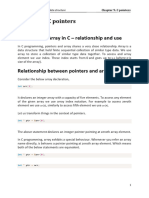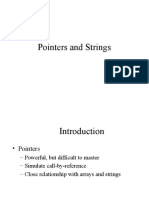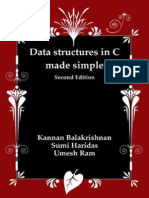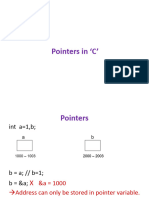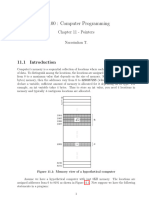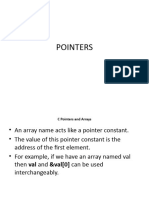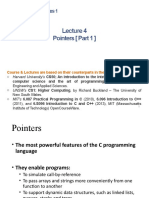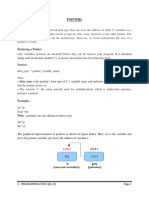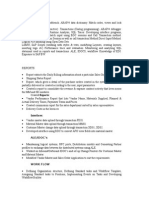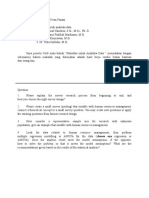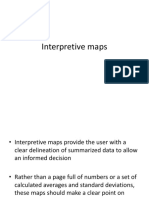Algorithmic and DYNAMIC data structure Chapter 9: C pointers
Chapter 9: C pointers
Pointer arithmetic in C
Pointer is a variable that points to a memory location. Memory addresses are
numeric value that ranges from zero to maximum memory size in bytes. These
addresses can be manipulated like simple variables. You can increment,
decrement, calculate or compare these addresses manually.
C language provides a set of operators to perform arithmetic and comparison of
memory addresses. Pointer arithmetic and comparison in C is supported by the
following operators
Increment and decrement ++ and --
Addition and Subtraction + and -
Comparison <, >, <=, >=, ==, !=
Pointer increment and decrement
Increment operator when used with a pointer variable returns next address
pointed by the pointer. The next address returned is the sum of current pointed
address and size of pointer data type.
Or in simple terms, incrementing a pointer will cause the pointer to point to a
memory location skipping N bytes from current pointed memory location.
Where N is size of pointer data type.
Similarly, decrement operator returns the previous address pointed by the
pointer. The returned address is the difference of current pointed address and size
of pointer data type.
For example, consider the below statements.
int num = 5; // Suppose address of num = 0x1230
int *ptr; // Pointer variable
ptr = # // ptr points to 0x1230 or ptr points to num
ptr++; // ptr now points to 0x1234, since integer size is 4 bytes
ptr--; // ptr now points to 0x1230
1
�Algorithmic and DYNAMIC data structure Chapter 9: C pointers
Note: Increment operation increments pointer address by the size of pointer data
type.
If an integer pointer ptr pointing at 0x1230, after ptr++ it will point
at 0x1234 (assuming integer size is 4 bytes).
If a character pointer cptr pointing at 0x1250, after cptr++ it will point
at 0x1251 (since character occupies 1 byte).
Pointer increment decrement operation memory representation
Example program to perform pointer increment
and decrement
Array in memory are stored sequentially, hence is the best example to
demonstrate pointer increment, decrement operations.
#include <stdio.h>
#define SIZE 5
int main()
{
int arr[SIZE] = {10, 20, 30, 40, 50};
2
�Algorithmic and DYNAMIC data structure Chapter 9: C pointers
int *ptr;
int count;
ptr = &arr[0]; // ptr points to arr[0]
count = 0;
printf("Accessing array elements using pointer \n");
while(count < SIZE)
{
printf("arr[%d] = %d \n", count, *ptr);
// Move pointer to next array element
ptr++;
count++;
}
return 0;
}
Output –
arr[0] = 10
arr[1] = 20
arr[2] = 30
arr[3] = 40
arr[4] = 50
Pointer addition and subtraction
Pointer increment operation increments pointer by one. Causing it to point to a
memory location skipping N bytes (where N is size of pointer data type).
We know that increment operation is equivalent to addition by one. Suppose an
integer pointer int * ptr. Now, ptr++ is equivalent to ptr = ptr + 1. Similarly, you can add
or subtract any integer value to a pointer.
Adding K to a pointer causes it to point to a memory location skipping K * N bytes.
Where K is a constant integer and N is size of pointer data type.
Let us revise the above program to print array using pointer.
3
�Algorithmic and DYNAMIC data structure Chapter 9: C pointers
Example program to demonstrate pointer
addition and subtraction
#include <stdio.h>
#define SIZE 5
int main()
{
int arr[SIZE] = {10, 20, 30, 40, 50};
int *ptr;
int count;
ptr = &arr[0]; // ptr points to arr[0]
count = 0;
printf("Accessing array elements using pointer \n");
while(count < SIZE)
{
printf("arr[%d] = %d \n", count, *(ptr + count));
count++;
}
return 0;
}
When count = 0, (ptr + count) is equivalent to (ptr + 0) which points
to arr[0] and hence prints 10.
When count = 1, (ptr + count) is equivalent to (ptr + 1) which points
to arr[1] and hence prints 20.
Similarly when count = 4, (ptr + count) is equivalent to (ptr + 4) which
points to arr[4] and hence prints 50.
Output of above program is same as first program.
Pointer comparison
In C, you can compare two pointers using relational operator. You can perform six
different type of pointer comparison <, >, <=, >=, == and !=.
4
�Algorithmic and DYNAMIC data structure Chapter 9: C pointers
Note: Pointer comparison compares two pointer addresses to which they point to,
instead of comparing their values.
Pointer comparisons are less used when compared to pointer arithmetic.
However, We frequently use pointer comparison when dealing with arrays.
Pointer comparisons are useful,
If you want to check if two pointer points to same location. For example,
int main()
{
int num = 10;
int *ptr1 = # // ptr1 points to num
int *ptr2 = # // ptr2 also points to num
if(ptr1 == ptr2)
{
// Both pointers points to same memory location
// Do some task
}
return 0;
}
If you want to check if a pointer points within an array range. For
example,
int main()
{
int arr[5] = {10, 20, 30, 40, 50};
int *ptr = &arr[0]; // ptr points to arr[0]
while(ptr <= &arr[4])
{
// ptr will always point within the array
// Do some task
// Move ptr to next array element
ptr++;
}
return 0;
}
5
�Algorithmic and DYNAMIC data structure Chapter 9: C pointers
Example program to demonstrate pointer
comparison
Let us re-write our array program without using count variable.
#include <stdio.h>
#define SIZE 5
int main()
{
int arr[SIZE] = {10, 20, 30, 40, 50};
int *ptr = &arr[0]; // ptr points to arr[0]
printf("Accessing array elements using pointer \n");
while(ptr < &arr[SIZE])
{
printf("%d \n", *ptr);
// Move to next array element
ptr++;
}
return 0;
}
Rules for performing pointer arithmetic
Pointer arithmetic can be a nightmare if not used correctly. Incorrect pointer
arithmetic will lead to you compilation error as well as program crash.
Following are some rules that you must mind while performing pointer arithmetic.
Result of two pointer addition or subtraction is an integer. For example,
int arr[] = {10, 20, 30, 40, 50};
int *ptr1 = &arr[0];
int *ptr2 = &arr[4];
int *ptr3 = ptr2 - ptr1; // ERROR -> (ptr2 - ptr1) evaluates to integer not
integer pointer
6
�Algorithmic and DYNAMIC data structure Chapter 9: C pointers
Result of pointer and integer addition or subtraction is a pointer. For
example,
int arr[] = {10, 20, 30, 40, 50};
int *ptr = &arr[0];
ptr = (ptr + 2); // ptr will now point to arr[2]
You must not use multiplication and division operator with pointers.
Valid and invalid examples of pointer arithmetic
int num=10, k=2; // Integer variable
int *ptr1, *ptr2, *ptr3; // Integer pointers
ptr1 = ptr1 – 2; // Valid
ptr1 = ptr1 – k; // Valid
ptr3 = ptr2 – ptr1; // Invalid, non-portable pointer conversion.
// Missing cast. See rule 1.
ptr3 = (int *) (ptr2 – ptr1) // Valid
ptr3 = ptr2 – ptr1 - k; // Invalid, non-portable pointer conversion.
// Missing cast. See rule 1.
ptr3 = (int *)(ptr2 – ptr1) + k; // Valid
ptr1 = ptr1 + 2; // Valid
ptr1 = ptr1 + k; // Valid
ptr3 = ptr1 + ptr2; // Invalid, non-portable pointer conversion.
// Missing cast. See rule 1.
ptr3 = (int *) (ptr1 + ptr2) // Valid
ptr3 = ptr1 + ptr2 + k; // Invalid, non-portable pointer conversion.
// Missing cast. See rule 1.
ptr3 = (int *)(ptr1 + ptr2) + k; // Valid
ptr1 = ptr1 * 2; // Invalid, illegal use of pointer. See rule 3.
ptr1 = ptr1 * k; // Invalid, illegal use of pointer. See rule 3.
ptr3 = ptr2 * ptr1; // Invalid, illegal use of pointer. See rule 3.
ptr1 = ptr1 / 2; // Invalid, illegal use of pointer. See rule 3.
ptr1 = ptr1 / k; // Invalid, illegal use of pointer. See rule 3.
ptr3 = ptr2 / ptr1; // Invalid, illegal use of pointer. See rule 3.








